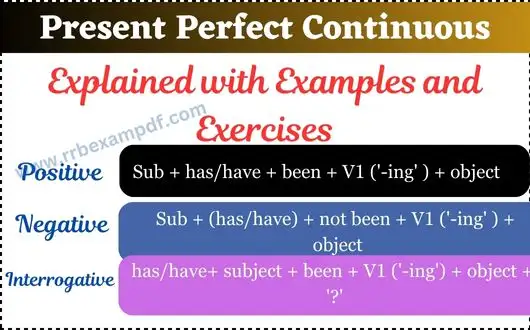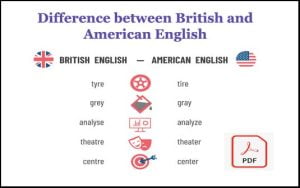Present Perfect Continuous Tense with examples: it is also known as present progressive perfect The Present Perfect Continuous tense is a powerful grammatical structure that allows us to describe ongoing actions that started in the past and continue up to the present moment. Whether you’re an English learner or someone seeking to enhance their language skills, understanding the different types of sentences and their formulas within the Present Perfect Continuous tense is crucial. In this article, we will delve into the various sentence structures, provide formulas for each, and offer practical exercises to solidify your understanding. Let’s embark on this journey to unlock the potential of the Present Perfect Continuous tense!

Types of Sentences in Present Perfect continuous Tense
In the Present Present perfect continuous Tense the sentences are of 4 types.
| Sentence Type | Formula | Example Sentences |
|---|---|---|
| Affirmative | Subject + auxiliary verb ‘have’ (has/have) + been + present participle (‘-ing’ form of the verb) + object/complement | 1. I have been studying for hours. 2. She has been working on the project all day. |
| Negative | Subject + auxiliary verb ‘have’ (has/have) + not been + present participle (‘-ing’ form of the verb) + object/complement | 1. They have not been playing football recently. 2. He has not been watching television lately. |
| Interrogative | Auxiliary verb ‘have’ (has/have) + subject + been + present participle (‘-ing’ form of the verb) + object/complement + ‘?’ | 1. Have you been exercising regularly? 2. Has she been working on the assignment? |
| Interrogative Negative | Auxiliary verb ‘have’ (has/have) + subject + not been + present participle (‘-ing’ form of the verb) + object/complement + ‘?’ | 1. Haven’t you been sleeping well lately? 2. Hasn’t he been studying for the test? |
1. Affirmative/ Positive Sentences
Affirmative sentences in the Present Perfect Continuous tense express ongoing actions that started in the past and are still happening in the present. The formula for constructing affirmative sentences is as follows: Present Perfect Continuous Tense with examples
Subject + auxiliary verb ‘have’ (has/have) + been + present participle (‘-ing’ form of the verb) + object/complement.
Example:
I have been studying for hours.
She has been working on the project all day.
Exercise 1:
Construct five affirmative sentences using the Present Perfect Continuous tense.
2. Negative Sentences
Negative sentences in the Present Perfect Continuous tense describe actions that have not been ongoing or have recently stopped. The formula for constructing negative sentences is as follows:
Subject + auxiliary verb ‘have’ (has/have) + not been + present participle (‘-ing’ form of the verb) + object/complement.
Example:
They have not been playing football recently.
He has not been watching television lately.
Exercise 2:
Convert the following affirmative sentences into negative sentences using the Present Perfect Continuous tense-
a) She has been practicing the piano for hours.
b) We have been studying French for months.
3. Interrogative Sentences
Interrogative sentences in the Present Perfect Continuous tense are used to ask questions about ongoing actions. The formula for constructing interrogative sentences is as follows:
Auxiliary verb ‘have’ (has/have) + subject + been + present participle (‘-ing’ form of the verb) + object/complement + ‘?’
Example:
Have you been exercising regularly?
Has she been working on the assignment?
Exercise 3:
Rewrite the following sentences in the Present Perfect Continuous tense as interrogative sentences:
a) He has been painting the house all day.
4. Interrogative Negative Sentences
Interrogative negative sentences in the Present Perfect Continuous tense ask questions about actions that have not been ongoing or have recently stopped. The formula for constructing interrogative negative sentences is as follows: Present Perfect Continuous Tense with examples
Auxiliary verb ‘have’ (has/have) + subject + not been + present participle (‘-ing’ form of the verb) + object/complement + ‘?’
Example:
Haven’t you been sleeping well lately?
Hasn’t he been studying for the test?
Exercise 4:
Convert the following affirmative sentences into interrogative negative sentences using the Present Perfect Continuous tense:
a) They have been traveling around the world.
Present Perfect Continuous Tense with Exercise
Congratulations! You have now grasped the different types of sentences and their formulas in the Present Perfect Continuous tense. By practicing these structures and engaging in exercises regularly, you will become proficient in expressing ongoing actions that started in the past and continue in the present. Remember to incorporate the Present Perfect Continuous tense into your speaking and writing, as it adds depth and precision to your language skills. Keep learning and exploring new horizons in English grammar!Present Perfect Continuous Tense with examples
Also Read: Past Tense with examples
Exercise Answers:
Exercise 1:
She has been reading a book all afternoon.
They have been playing basketball for hours.
We have been waiting for the bus since morning.
I have been studying English grammar this week.
Exercise 2:
a) She has not been practicing the piano recently.
b) We have not been studying French lately.
Exercise 3:
a) Have they been playing soccer since morning?
b) Has he been painting the house all day?
Exercise 4:
a) Haven’t we been working on this project for weeks?
b) Haven’t they been traveling around the world?



